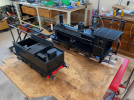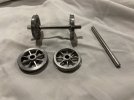David Taylor
Western Thunderer
The 4-4-0 has a new cab! I decided the old one wasn't good enough and built the new one from 0.015 NS. Nicer to work with than tinplate and seems to solder about as well. If only you could buy the stuff in Australia rather than importing silly little sheets of it.
The new cab fits the footplate curves a bit better and is obviously stiffer, so that's good. I turned some brass spectacle plate window surrounds and a little pressure gauge.
More fitting of the firebox wrapper, carving out of the splasher tops, and lowering of the smokeox lets the boiler fit. It might still be pointing upwards a bit, but I think the handrails on the side of the cab point down a bit, so it's hard to be sure.
The cab side handrails are interesting. There is a band of metal just under the cut-out which has a handrail running along it. This band extends forward and aft of the cab side and tapered stanchions are located in rolled ends of band. Not done that bit yet obviously.
Unfortunately the firebox doesn't fit exactly to the splashers, and I cut out too much of the splasher tops, but I am hoping I can live with these errors.
I think I'll do the safety and clack valves next, and some extra plates on the drag-beam.
Pictures!



The new cab fits the footplate curves a bit better and is obviously stiffer, so that's good. I turned some brass spectacle plate window surrounds and a little pressure gauge.
More fitting of the firebox wrapper, carving out of the splasher tops, and lowering of the smokeox lets the boiler fit. It might still be pointing upwards a bit, but I think the handrails on the side of the cab point down a bit, so it's hard to be sure.
The cab side handrails are interesting. There is a band of metal just under the cut-out which has a handrail running along it. This band extends forward and aft of the cab side and tapered stanchions are located in rolled ends of band. Not done that bit yet obviously.
Unfortunately the firebox doesn't fit exactly to the splashers, and I cut out too much of the splasher tops, but I am hoping I can live with these errors.
I think I'll do the safety and clack valves next, and some extra plates on the drag-beam.
Pictures!
























